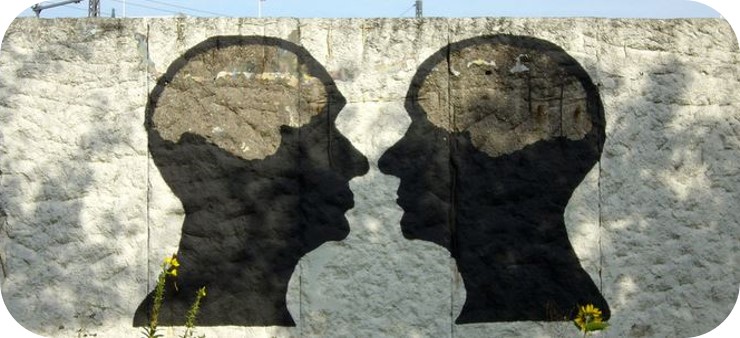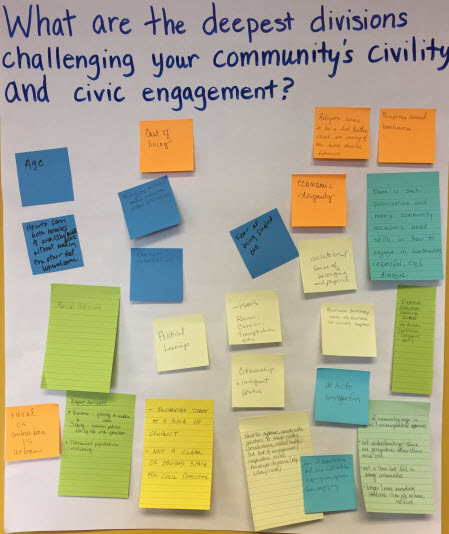Public Libraries and Civic Engagement: Identifying Challenges and Opportunities
“By sharing our hopes, concerns, questions and strategies with other librarians from around the region, I saw something I find myself re-learning all the time, in so many ways: that we are all more alike than we think. My library serves a quarter-million people, but we are facing many of the same opportunities and challenges as communities with two million residents. My community has many rural and small-town areas, but we are considering some of the same ideas as our very urban counterparts.”
Audrey Barbakoff, Adult Services Manager, Kitsap Regional Library
The annual Citizen University Conference is held just down the road from WebJunction’s Seattle office. In its 12th year, the conference recently gathered together more than 500 change-makers, catalysts and activists for presentations, panels and discussions on topics related to citizen power. This year’s conference focused on the need “to reckon with injustice across ideological divides and to repair our frayed social fabric.” The event provided the opportunity to invite libraries from Washington State’s Puget Sound region to join us for a preconference conversation on how libraries can support these important community needs.
Most of our work at WebJunction happens online, so when there’s a chance for us to meet face-to-face with library staff, we leap! The afternoon before the conference, we hosted 13 librarians for a preconference gathering, rich with discussion. Participants represented Pierce County Library System, Seattle Public Library, King County Library System, Sno-Isle Libraries, Kitsap Regional Library and TASCHA (Technology and Social Change Group at the University of Washington’s iSchool).
With a greater sense of urgency about how we connect in our communities and as a nation, this preconference was intended as an opportunity for participants to expand their regional networks, learn from what other libraries are doing and get input on their own initiatives.
This summary includes links to resources about our preconference activities. We hope that by including not just what we did but also a bit on how we did it, others will be inspired by this framework and use it to host similar gatherings in other regions.
Pre-gathering survey
Drawing on the conference theme, Reckoning and Repair in America, we asked participants to complete a short survey about their interests in advance of the meeting. Our agenda was guided by the group’s interests, much like an unconference.
In the survey, three priority themes emerged:
- Civility and civic engagement
- Equity, diversity and inclusion
- Literacies—especially programs/resources on information, media and privacy literacies
Silent conversation
After introductions and an icebreaker, everyone participated in a “silent conversation.” (You can read more about variations on the silent conversation approach here. The goal is to surface ideas from everyone, especially from those who may be less likely to speak up, and to allow for silence as people process the questions.)
- For this activity, big sheets of paper were placed around the room with questions associated with the priority themes.
- Participants were given ten minutes to write their responses on sticky notes and place these on the appropriate sheet.
WebJunction facilitators then read aloud each response. Below are the themes, questions and a summary of responses that were shared.
Community Engagement
What are the deepest divisions challenging your community’s civility and civic engagement?
- There is polarization and fragmentation along multiple points in our society—economic, political, geographic, racial, cultural, etc.
- Fears due to their citizenship status prevent many immigrants from engaging with the library and the community at large.
- Our community members need skills and safe spaces for engaging in civil dialogue.
Equity, Diversity and Inclusion
What ongoing or new challenges do our communities face in advancing equity, diversity and inclusion?
- Institutional and cultural biases have resulted in the exclusion of some communities from program planning. More visible examples of racism, misogyny, xenophobia, transphobia and other —isms and phobias have increased the fear level in marginalized communities. Because of implicit biases, there are community members who don’t perceive the problems of those facing intolerance, inequity and exclusion. There is a need for better skills to raise awareness and make the case for equity, diversity and inclusion.
- In addition to new challenges to our communities, ongoing issues of poverty, mental health and drug use are also on the rise.
- We need to find new ways of engaging and connecting people of differing viewpoints in activities that go beyond dialogue.
Literacies
How has the current political environment changed your community’s learning needs for digital and information literacy (privacy, voting, health, media literacies, etc.)?
- There is an increased interest in civic engagement and political literacy. Many community members want to understand how to participate in the political process and advocate for their rights—for some, this is the first time they’ve engaged; for others, they might be seeking citizenship materials and resources.
- There are renewed concerns about privacy, especially among marginalized communities.
- Our community members want help discerning the news and accessing credible information. Concerns about biased or fake news have highlighted the importance of literacies.
Small group discussions
At the end of the silent conversation, everyone was encouraged to take notes as the responses were read aloud to highlight anything they’d like to discuss further in a small group setting.
We broke into small groups to talk about how each library is addressing these issues currently, what (else) they’d like to be doing and to learn about other libraries’ approaches.
Participants expressed that the small group discussions were energizing, especially following the sobering lists generated during the silent conversation. Here are each of the themes as discussed in the small groups, along with some of the approaches, solutions and strategies.
Community engagement follow-up discussion
What is your library doing to address these divisions and promote community connections? What more would you like to be doing?
- Libraries are hosting programs that encourage community dialogue. Events planned and facilitated in partnership with other community agencies can be especially effective. One example is Sno-Isle Libraries’ Issues that Matter program, a series of public forums focused on homelessness in the region. Structure community discussions about hot topics in a manner that fosters productive dialogue, for example, the “PechaKucha” format.
- Participants discussed the challenge of hosting discussions about controversial topics at the library, and the need for training in facilitation. Libraries may need to be prepared to advocate for free speech, even in situations where staff are not in agreement with the viewpoints presented; libraries offer unique opportunities for dialogue. Library staff shared stories of occasions when they provided space for open, honest and sometimes difficult conversations—and disagreeing neighbors came together and practiced civility, even with picketing and protests.
- Library staff outlined potential topics to explore as part of community conversation events, including: refugees, family safety (in Spanish) and allyship (how to be a good ally).
Equity, diversity and inclusion follow-up discussion
What is your library doing to address these challenges? What more would you like to be doing?
- Many examples and resources surfaced for serving the homeless, including the Coffee and Conversation hour hosted as part of the Homeless Engagement Initiative at the Dallas Public Library.
- One library recently added a social worker position with office hours.
- When staff or others in library spaces experience hate speech, strategies include providing staff with talking points, in order to demonstrate leadership and organizational buy-in. Encourage staff, if possible, to use the “tag-out” strategy: when a staff member, feeling overwhelmed, can tell a colleague, “I need to tag out of this situation.”
- One library is developing a strategic framework to provide clarity around its role in addressing equity, diversity and inclusion. Try to work with other organizations to create a community-wide statement around serving those who are marginalized or excluded. It would be helpful for libraries to have a task force focused on these issues and the related need for staff training on cultural competencies, cultural compassion and civility.
- Libraries have a variety of strategies for reaching out to community members who might not feel welcome. Outreach events could be held elsewhere; schools may be perceived as a safer space for those new to the community who don’t feel safe at the library. King County Library System hosts storytimes in 15 languages. Often the storyteller comes from a particular culture or segment of the community—they have the trust of those community members and they bring that community to the library.
Literacies follow-up discussion
What is the library’s role and what could libraries be doing to address digital and information literacies? What more would you like to be doing?
- Although libraries are hosting workshops to help community members spot biased or fake news, some worry that people won’t show up because of the belief that “I’m not the one who believes in fake news.” One strategy is to address fake news as part of a program or event that is more broadly about information literacy.
- The Gail Borden Public Library recently hosted a panel, "Librarians vs. Fake News." Also see this round-up of resources from the ALA Public Programs office.
Crafting talking points: 27-9-3 activity
Our final activity was designed to help create talking points that could be used by anyone in conversations in and around our communities regarding civic engagement and public libraries.
Participants teamed up with their colleagues and used the 27-9-3 method (27-9-3 rule explained in a short webinar and 27-9-3 Rule worksheet) to create a persuasive “pitch” statement that can be presented using no more than 27 words, within a time frame no longer than nine seconds, and discussing no more than three points. Here’s a great example created by one of the teams: “We all care deeply about building a stronger, more inclusive community. You are empowered to move the needle by partnering directly with marginalized communities to address their needs.”
Wrap-up session: key takeaways and next steps
The day ended with each team reading their 27-9-3 statement, and then a trip around the room to share key takeaways from afternoon. Participants shared:
- Realizing how much we have in common
- The more we can get together the better
- Gaining clarity about the topics we’re facing
- Hearing from other libraries; despite the range of sizes, types and localities, our communities share similar issues
- Libraries are uniquely positioned to respond
“It was really beneficial to have these discussions with other libraries and see firsthand that we all are facing the same community issues. It's great to hear how everyone is addressing them. I found the small group conversations invigorating.” Danielle Dreger-Babbitt, Teen Services Coordinator, Sno-Isle Libraries
Our next steps
Next week, we’ll publish a reflection piece on the Citizen University Conference on WebJunction.org, and we are exploring how best to follow-up on this gathering. If you have responses or strategies to share with our readers, please contact us via [email protected].
Moved by the dedication and love for the communities our libraries serve, we wholeheartedly agree with Kitsap Regional Library’s Audrey Barbakoff: “The more we can come together like this to talk about each other’s experiences, the better we can all do in inspiring and empowering the people we serve.”
Related Resources on WebJunction
- Access & Equity (topic area)
- Racial Justice and Libraries at Citizen University Conference, by Anna Shelton
- Whole Person Librarianship: Fostering Empathy in Challenging Times (webinar)
- Civility Goes Viral: A New Approach for a New Era (webinar)
- Beyond the Welcome Sign: Tailoring Immigrant Services for Success (webinar)


